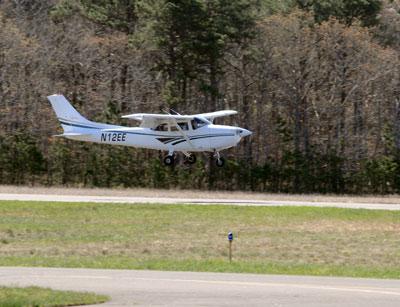Restrictions at Airport, but Which Ones?

The question of what kinds of restrictions East Hampton Town may be allowed to place on the use of its airport in an effort to control noise turns largely on whether the town seeks to restrict jets and seaplanes or focuses access restrictions on helicopters.
Airport operators must comply with Federal Aviation Administration rules and may not unreasonably restrict access or discriminate against particular types of airport users. The scenarios and possibilities differ, however, depending on whether or not the airport has accepted F.A.A. money, to which a number of contractual obligations, or grant assurances, are tied.
In a presentation to the East Hampton Town Board on Tuesday, Peter Kirsch, an aviation attorney working with the town on a comprehensive approach to airport management, said that the F.A.A. gives airport owners the authority to enact rules governing aircraft categorized as stage one and stage two, which includes helicopters, even under the grant assurances. However, the agency’s approval is required before enacting rules governing stage three or stage four aircraft, which includes jets and seaplanes.
Should the town cease taking F.A.A. money, allowing existing grant assurances to expire in 2014, the agency’s approval would not be needed for rules on any kind of aircraft. The F.A.A. could, however, sue the town, challenging it to prove that its rules meet legal standards. The town would have to provide sufficient data to show that its rules were a reasonable reaction to a documented noise problem.
Citing the degree of difficulty in successfully enacting access restrictions under the F.A.A. grant assurances, airport noise-control advocates, such as the Quiet Skies Coalition, had asked the town board to reconsider applying for new federal funds. Information provided by the F.A.A. to Representative Tim Bishop earlier this year, specifically stating for the first time that local regulations could be enacted without submitting to the F.A.A.’s review process should the town no longer take federal airport money, should be carefully considered by the board, the advocates said.
In response, the board asked Mr. Kirsch to address the matter. “If the town were seriously thinking of restrictions on stage three [aircraft], that would be a big deal,” he said. But, he said, “I don’t believe it’s a big deal” under the understanding that the town is considering only rules to limit use of the airport by helicopters. The town board has not specifically discussed that option in public.
Mr. Kirsch recommended that the board continue with a multipronged approach, under which federal funds would be solicited to pay for airport projects, but data collection supporting potential future airport restrictions would also begin.
“I believe the comprehensive management plan takes all of these factors into consideration and positions the town to move forward with restrictions,” he said.
In comments to the board before Mr. Kirsch’s presentation, Kathleen Cunningham, the president of the Quiet Skies Coalition, said that the F.A.A.’s assertion that it would not sue the town if it instituted access limits once free of the grant assurances, after 2014, “is a window of opportunity for the town to explore other options, and I would urge you to take advantage of that.”
Those concerned about airport noise, she said, “are not interested in shutting the airport down. We are also interested in safety. What we are interested in is the town’s ability to limit access, which is the true noise-abatement tool, and the ability of the town to limit types of aircraft, and the times they will come in.”
Also speaking at the meeting were a number of airport users, including Cindy Tuma, the owner, with her husband, of Sound Aircraft, which is based at East Hampton Airport. “Please maintain the airport as the asset that it is,” she said. “In order to do that, you need to accept federal funds.”
Runway 4-22, which has been closed because of disrepair, is needed for safety and should be reopened, speakers said. Without federal money, they said they feared the airport would become too expensive for the town to keep open.
